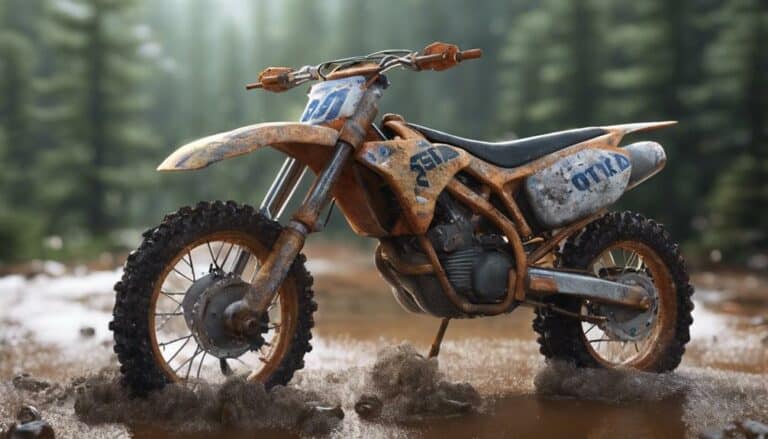Ever wondered if the temperature and riding conditions truly make a difference in the type of oil you choose for your dirt bike?
When it comes to maintaining your bike's engine performance and longevity, the impact of these factors on oil selection is essential.
You'll be surprised at how much the right oil can enhance your bike's overall performance and reliability, so let's explore how temperature and riding conditions play a pivotal role in this decision-making process.
Key Takeaways
- Engine temperature influences oil viscosity, requiring specific grades for hot or cold climates.
- Riding conditions impact oil stability, demanding oils for extreme pressures and water resistance.
- Viscosity grades determine oil flow at different temperatures, crucial for engine longevity.
- Synthetic oils offer superior performance in extreme conditions, providing enhanced lubrication and heat protection.
The Role of Temperature in Oil Selection
When selecting oil for your dirt bike, the temperature of the riding environment plays a critical role in determining the oil's viscosity and overall performance. Engine temperature directly affects the viscosity index of the oil. Higher temperatures cause the oil to thin out, potentially leading to inadequate lubrication, while lower temperatures can cause the oil to thicken, impacting its flow properties.
In hot climates or during intense riding conditions, opting for oil with a higher viscosity index is essential. This choice guarantees that the oil maintains its viscosity, offering proper lubrication and engine protection. Conversely, in cold weather or for short rides, oils with good cold flow properties are necessary to guarantee adequate lubrication during start-up and operation.
Extreme temperature variations can accelerate oil breakdown, emphasizing the necessity of selecting oils with excellent thermal stability. Considering the temperature range of the riding environment is paramount in choosing the right oil. This consideration is crucial to ensure proper engine protection and performance for your dirt bike under varying riding conditions.
Impact of Riding Conditions on Oil Choice
In off-road environments with hot and dusty riding conditions, selecting oils with superior heat resistance becomes important for maintaining top dirt bike performance. When considering the impact of riding conditions on oil choice, several factors come into play:
- Engine Stress: Frequent stop-and-go riding or long idling periods can increase engine stress, requiring oils that maintain stability under such conditions.
- High-Performance Demands: High-performance dirt bikes used in racing or aggressive riding styles put more strain on the engine, necessitating oils that can handle extreme pressures and maintain performance.
- Water Contamination: Riding in wet or muddy conditions can introduce water contamination to the engine oil, underscoring the need for oils with excellent water resistance and corrosion protection.
- Versatile Performance: Dirt bikes used in varied terrains and riding styles may benefit from synthetic oils offering consistent performance, enhanced engine protection, and extended drain intervals to accommodate demanding operating conditions.
Choosing the right oil tailored to the specific riding conditions can have a significant impact on engine performance and longevity on your dirt bike.
Understanding Viscosity Grades for Dirt Bikes
Considering the demands of off-road environments and the specific needs of your dirt bike, understanding viscosity grades is paramount for selecting the best oil to guarantee peak performance and engine protection. Viscosity grade directly impacts how oil flows at different temperatures, affecting lubrication efficiency and engine protection. Lower viscosity grades like 10W-30 are well-suited for cold start-ups, ensuring quick lubrication in colder riding conditions. On the other hand, higher viscosity grades like 20W-50 are more appropriate for hot weather or high-stress riding scenarios, maintaining oil film strength under extreme conditions. It is essential to comprehend the temperature ranges associated with viscosity grades to make an informed choice that aligns with your dirt bike's requirements. Manufacturers' guidelines and the engine's specific needs also play an important role in determining the best viscosity grade for your dirt bike.
| Viscosity Grades | Suitable Conditions |
|---|---|
| 10W-30 | Cold start-ups, colder conditions |
| 20W-50 | Hot weather, high-stress riding |
Synthetic Vs. Conventional Oils for Dirt Bikes
For optimal performance and enhanced engine protection in dirt bikes, choosing between synthetic and conventional oils is a critical decision influenced by their distinct properties and capabilities.
When considering the choice between synthetic and conventional oils for your dirt bike, it's essential to understand their differences in handling engine stress, temperature resistance, and lubricant qualities. Here's what you need to know:
- Synthetic oils offer superior temperature resistance, making them ideal for high-stress conditions and intense riding situations.
- Conventional oils may struggle to withstand prolonged high-stress conditions and could break down faster under extreme temperatures.
- Synthetic oils provide enhanced heat protection, essential for maintaining engine performance during demanding rides.
- Conventional oils may not offer the same level of lubricant qualities as synthetic oils, potentially impacting overall engine reliability in varying riding conditions.
Recommendations for Optimal Oil Selection
When selecting the ideal oil for your dirt bike, prioritize temperature resistance, shear stability, anti-foaming properties, wear protection, and lubrication under high RPM conditions. Opt for synthetic motor oils that offer superior temperature resistance, ensuring best performance in extreme heat conditions commonly encountered in dirt biking.
Look for oils with excellent shear stability to withstand the intense engine stress experienced during aggressive riding sessions. Choosing oils with advanced anti-foaming properties is important for maintaining consistent lubrication in rough terrains.
For dirt bikes used in dusty or sandy environments, select oils with enhanced wear protection to prolong engine life. Additionally, prioritize oils that provide best lubrication under high RPM conditions to support the engine during high-speed rides.
Conclusion
In summary, when selecting oil for your dirt bike, consider the temperature and riding conditions to guarantee top performance and engine longevity.
Remember that high-performance oils are vital for hot weather and intense riding, while different viscosities may be more suitable for colder temperatures and less demanding conditions.
By understanding viscosity grades, choosing between synthetic and conventional oils, and following recommendations, you can keep your dirt bike running smoothly and efficiently.

